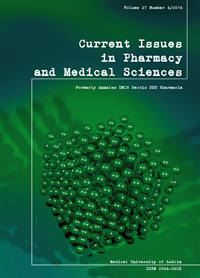Multiprobiotic therapy from childhood prevents the development of nonalcoholic fatty liver disease in adult monosodium glutamate-induced obese rats
DOI:
https://doi.org/10.1515/cipms-2015-0025Keywords:
monosodium glutamate, non-alcoholic fatty liver disease, multiprobioticAbstract
Considering the association between microflora and obesity, and the significantly higher prevalence of non-alcoholic fatty liver disease (NAFLD) in obese people, the aim of our study was to investigate the preventive effect of multiprobiotics on the monosodium glutamate (MSG) induced NAFLD model, in rats. The work was carried out on 60 rats placed into three groups: the Control group, the MSG-group and the MSG-probiotic group. The MSG-group and the MSG-probiotic group were injected with 4 mg/g of MSG subcutaneously neonatally on the 2nd-10thdays of life. The MSG-probiotic rats were also treated with 140 mg/kg of multiprobiotic “Symbiter” from the 4thweek of life. In the 4-month-old rats, biochemical and morphological changes in liver were assessed, and steatosis was confirmed by the NAFLD activity score (NAS). Our results reveal that the multiprobiotic lowered total NAS, the degree of steatosis and the liver lobular inflammation caused by MSG. It also brought about decreased liver total lipids and triglycerids content, as well as decreased visceral adipose tissue mass. However, there was no difference in the liver serum biochemical indicators between all experimental groups. The obtained data does suggest the efficacy of probiotics in the prevention of NAFLD.
References
1. Angulo P.: Medical progress: nonalcoholic fatty liver disease. The New England Journal of Medicine, 346, 16, 1221-1231, 2002.
2. Backhed F. et al.: The gut microbiota as an environmental factor that regulates fat storage. Proc. Natl Acad. Sci. USA, 101, 15718-15723, 2004.
3. Caricilli A.M., Saad M.J.: Gut microbiota composition and its effects on obesity and insulin resistance. CurrOpinClinNutrMetab Care, 17, 4, 312-318, 2014.
4. Cesaro C. et al.: Gut microbiota and probiotics in chronic liver diseases. Dig Liver Dis,43, 431-8, 2011.
5. Eslamparast T. et al.: Probiotics and Nonalcoholic Fatty liver Disease. Middle East J Dig Dis, 5, 3, 129-136, 2013.
6. Folch, J., Lees, M., Stanley, G.H.S: A simple method for the isolation and purification of total lipids from animal tissues. J. Biol. Biochem., 226, 497-509, 1957.
7. Frazier T.H., DiBaise J.K., McClain C.J.: Gut Microbiota, Intestinal Permeability, Obesity-Induced Inflammation, and Liver Injury. JPEN J Parenter Enteral Nutr,35, 14S-20S, 2011
8. Kondro M. et al.: Metabolic profile and morpho-functional state of the liver in rats with glutamate-induced obesity. Curr. IssuesPharm. Med. Sci.,26, 4, 379-381, 2013.
9. Raoult D, Henrissat B.: Are stool samples suitable for studying the link between gut microbiota and obesity? Eur J Epidemiol., 29, 5, 307-309, 2014.
10. Turnbaugh P.J. et al.: Diet-induced obesity is linked to marked but reversible alterations in the mouse distal gut microbiome. Cell Host Microbe, 3, 213-223, 2008.
Downloads
Published
Issue
Section
License
Copyright (c) 2015 Authors

This work is licensed under a Creative Commons Attribution-NonCommercial-NoDerivatives 3.0 Unported License.


